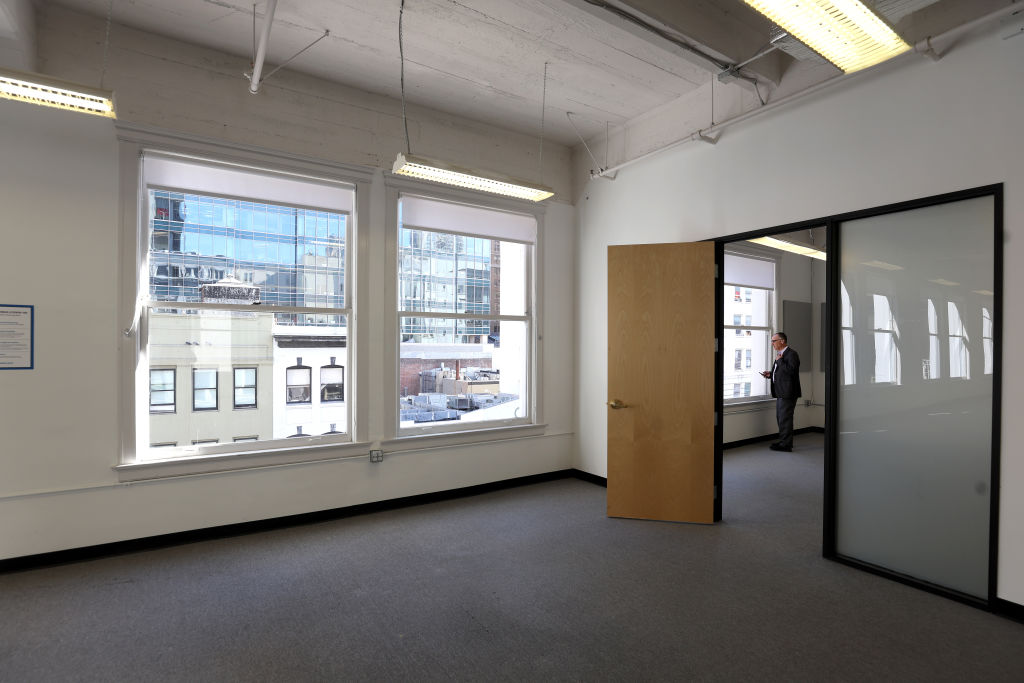
An office sits vacant in San Francisco in October 2022. The city is one of several across the country offering incentives to convert unused office space into housing. (Justin Sullivan/Getty Images)
Read more Stateline coverage of how communities across the country are trying to create more affordable housing.
Nearly a fifth of office space across the country sits empty, a record high vacancy rate that’s expected to keep growing.
Seeking both to boost their economies and ease their housing shortages, cities are taking steps to encourage the conversion of unused office space into much-needed housing. They include reductions in approval times, exemptions from affordable housing rules and changes in building code requirements. Some cities and states also are providing tax incentives or subsidies to developers.
“Cities need to focus on making conversions feasible by removing unnecessary regulatory barriers,” said Alex Horowitz, project director of the Housing Policy Initiative at The Pew Charitable Trusts.
“The U.S. is short millions of homes, and office vacancy rates are at record highs. It makes all the sense in the world to convert underused commercial space into housing, but the cost per square foot is just too high.”
Too many cubicles, too few homes spur incentives to convert offices to housing
Purchasing and converting an office building for residential use costs an average of $685 per square foot. Buying a completed multifamily property costs an average of $600 per square foot, while building a new multifamily development costs about $588 per square foot.
Regulatory hurdles — such as outdated building codes, minimum unit sizes and natural light requirements — push up costs. Cities are trying a variety of ways to overcome these obstacles.
From coast to coast
In September, Minneapolis peeled away several regulations in an effort to encourage conversions, including removing public hearing requirements, requiring less intensive traffic studies, and exempting converted buildings from the typical requirement that 20% to 30% of units be rented at below-market rates.
San Francisco has waived certain planning and building code requirements as well as real estate transfer taxes for downtown conversions that are approved before 2030.
Seattle in July approved exemptions for commercial-to-residential conversions from certain design development standards and from housing affordability requirements.
New York City’s Office Conversion Accelerator program provides a single point of contact for office building owners to streamline conversions, from zoning questions to permitting.
And Denver last year launched an adaptive reuse pilot program to make it easier and faster to get conversions approved by the city.
Jon Gambrill, managing director of global architecture firm Gensler’s Denver office, said that converting the top 16 buildings identified by the firm and city leaders into housing could add more than 5,000 units to the downtown area.
It makes all the sense in the world to convert underused commercial space into housing, but the cost per square foot is just too high.
– Alex Horowitz, project director of the Housing Policy Initiative at The Pew Charitable Trusts
Atlanta, Denver, Phoenix, the San Francisco Bay Area and Seattle stand to benefit the most from converting underused offices to housing, according to a June Urban Institute analysis.
Still, conversions have made little dent in the housing crisis so far.
Between 2016 and April 2024, office-to-multifamily conversion projects created more than 22,000 apartments, according to CBRE, a commercial real estate services and investment firm. The 169 projects planned or underway are estimated to produce another 31,000 apartments over the next several years. Despite the growth, that total is less than a half-percent of total U.S. apartment inventory.
During a June presentation by Seattle’s Office of Planning and Community Development, city leaders estimated that they expect fewer than a dozen conversion projects to result in 1,000 to 2,000 new housing units over seven years.
Money matters
Cities and states also are trying to promote conversions by offering incentives and funding.
New York City’s 2025 budget included a new incentive for conversion of commercial properties to rental housing, offering up to a 90% tax exemption for projects with at least 25% affordable units.
Chicago has committed $151 million for developers to transform four office buildings into 1,000 apartments, about a third of which would have affordable rental rates.
California’s rent control rejection might point to national appetite for different approach
Washington, D.C., provides 20-year tax abatements for commercial-to-residential conversions through its Housing in Downtown initiative.
The District of Columbia led the nation in adaptive reuse from 2021 to 2024, creating 5,820 new housing units from office properties, followed by New York (5,215 units) and Dallas (3,163 units), according to RentCafe, an apartment search website.
California in 2022 approved $400 million for office-to-residential projects.
Commercial-to-residential legislation has hit some hurdles.
California Democratic Gov. Gavin Newsom in October vetoed legislation that would have provided financial incentives for developers, including the option for local governments to allocate up to 30 years of property tax revenue to support affordable housing conversions. It also would have fast-tracked the approval process for conversion of office buildings into residential or mixed-use developments.
Newsom objected to changes in labor practices including the issuance of stop-work orders for violations and procedures for contesting violations.
And in Colorado, a bill that would have offered refundable tax credits up to $3 million per commercial-to-housing project starting in 2026 failed in the legislature earlier this year.
Still, experts expect housing conversion efforts to increase across the country.
“All Americans, particularly underserved communities, need homes they can afford,” said Pew’s Horowitz. “But outdated rules make it harder to create deeply affordable housing.”
Stateline is part of States Newsroom, a nonprofit news network supported by grants and a coalition of donors as a 501c(3) public charity. Stateline maintains editorial independence. Contact Editor Scott S. Greenberger for questions: info@stateline.org. Follow Stateline on Facebook and X.

